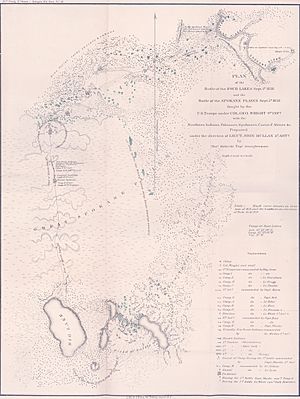Battle of Spokane Plains facts for kids
Quick facts for kids Battle of Spokane Plains |
|||||||
|---|---|---|---|---|---|---|---|
| Part of the Coeur d'Alene War, Yakima War | |||||||
 Map showing the Battle of Four Lakes and the Battle of Spokane Plains |
|||||||
|
|||||||
| Belligerents | |||||||
| Kalispel Palus Schitsu'umsh (Coeur d'Alene) Spokan Yakama |
|||||||
| Commanders and leaders | |||||||
| George Wright | Kamiakin | ||||||
| Strength | |||||||
| ~700 (including 200 civilian drovers) |
~500 to 700 | ||||||
| Casualties and losses | |||||||
| 1 (wounded) | 6 (dead) unknown wounded |
||||||
The Battle of Spokane Plains was an important fight during the Coeur d'Alene War in 1858. This war took place in what is now Washington and Idaho. The Coeur d'Alene War was actually part of a bigger conflict called the Yakima War, which started in 1855. The battle happened west of Fort George Wright, near the city of Spokane, Washington. It was fought between the United States Army and a group of Native American tribes. These tribes included the Kalispel (also known as Pend Oreille), Palus, Schitsu'umsh (Coeur d'Alene), Spokan, and Yakama warriors.
Contents
Why the Battle Happened
Even though their lands were protected by treaties, the Schitsu'umsh people were very upset. Miners and white settlers were moving onto their territory without permission. They also worried about the Mullan Road, a new road being built. They saw this road as a sign that the United States wanted to take more of their land.
Two white miners were killed, and the U.S. Army decided to fight back. The Coeur d'Alene War began with the Battle of Pine Creek on May 17, 1858. In that battle, a smaller U.S. Army group was defeated by warriors from several tribes.
Colonel Wright's Campaign
After the U.S. Army's defeat at Pine Creek, Colonel George Wright took charge. He was the commander of Fort Dalles. Colonel Wright gathered a much larger force. He had about 500 Army soldiers and 200 civilian workers who helped move supplies. He also had 30 Niimíipu (or Nez Perce) scouts. These scouts were Native Americans who helped the Army find their way and gather information.
Wright's group first went to Fort Walla Walla. Then they moved north towards the Spokane Plains, near modern-day Spokane, Washington. On September 1, 1858, Wright's soldiers fought and defeated a group of about 500 warriors. These warriors were led by the Yakama chief, Kamiakin. This fight was called the Battle of Four Lakes.
The Battle of Spokane Plains Begins
After winning the Battle of Four Lakes, Colonel Wright and his men rested for three days. On September 5, 1858, they started moving north again. They had gone about 5 miles (8 km) when they reached the Spokane Plains.
Here, a new group of 500 to 700 Kalispel, Palus, Schitsu'umsh, Spokan, and Yakama warriors began to attack. The Native American warriors used clever tactics. They would ride quickly towards the Army column, fire their weapons, and then speed away. This made it hard for the soldiers to shoot back effectively.
Colonel Wright decided to move his troops towards a small forest about 9 miles (14 km) further north. As the Army reached the forest, the Native Americans set the dry prairie grass on fire all around them. Thick smoke filled the air, making it hard to see. The Native Americans tried to use the smoke to get close and capture the Army's supply wagons.
The Army's foot soldiers fired their weapons, pushing the Native Americans back into the woods. Wright then used his powerful cannons, called howitzers and guns, to shoot into the trees. The Army soldiers had new Springfield Model 1855 rifle-muskets. These rifles could shoot very far, up to 1,000 yards (914 m). However, the smoke from the prairie fire helped the Native American horsemen. It allowed them to get closer without being seen, making the long range of the rifles less useful.
Turning the Tide
Wright then changed direction, moving east-northeast towards the Spokane River. By having the river behind them, his men could focus their fire better and protect themselves. After moving about 2.5 miles (4 km), Wright stopped briefly for his supply wagons to catch up.
Then, he ordered his 30 Niimíipu scouts to ride ahead. These scouts, led by 1st Lt. John Mullan, checked the land to make sure the Army was going the right way. Next, three companies (groups) of Wright's best shooters moved forward. They formed a "skirmish line," spreading out to break up the Native American attacks.
Wright's cavalry (soldiers on horseback) followed. They charged directly into the enemy lines, scattering the warriors. Whenever the Native Americans tried to gather again in the forest, the Army's howitzers and cannons would fire into the trees. Chief Kamiakin himself was hurt when a tree branch, shattered by cannon fire, fell on him.
Aftermath of the Battle
By the time night fell, the Army had reached the Spokane River. The Native American warriors had scattered and left the area. Only one U.S. soldier was slightly injured, even though the Army had marched about 25 miles (40 km) through almost constant gunfire. At least six Native Americans were confirmed dead, and three were wounded. The actual number of wounded was likely much higher.
Chief Kamiakin had managed to bring together warriors from different tribes twice. This was a difficult thing to do, especially after his forces had lost a big battle just three days earlier. His forces had come very close to defeating the professional soldiers. They used prairie fires, confusion, and quick hit-and-run attacks.
However, the Army's victory at Spokane Plains broke Kamiakin's alliance. This battle effectively ended the Coeur d'Alene War. On September 17, the Schitsu'umsh chiefs signed a surrender document.

